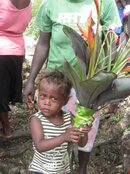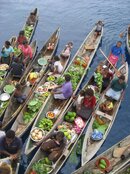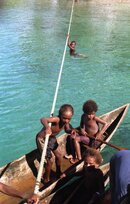I had a great trip to the Solomon Islands with 2 weeks on the Bilikiki in November 2009. Sorry for the delay in getting a trip report up on the board!
It is a long report, but I have grouped by topic to make it easier to find what you might need.
Ill start with the fish-life and then leave the nitty-gritty details for last for those who are interested.
SORRY NO UW PHOTOS FROM ME!
Under the Water
Diversity is the best way to describe what we encountered in the Solomon Islands. From pygmy seahorses & lots of macro critters to 7 different anemone species to large schools of barracuda to mantas and the occaision sharks, you will find loads of marine life. As others have pointed out, other places in the Coral Triangle may have more of a certain thing, but youll get a well-rounded view of things in the SI. Looking back at my dive log, I could go on and on about the things I noted. I loved the huge variety of nudibranchs and flatworms (Kellie the boat manager & I found one that she had never seen before), the pajama cardinal fish, the archer fish, the freckled face blennies, the Maori/Napoleon wrasse .Ill stop now!
In addition, there are some unique dive sites. White Beach has sunken remains of a US Naval base from WWI that is full of fish life. You might encounter a small salt-water croc in a shallow pond. You can also dive the Bat Cave and surface briefly to see and hear the bats flying overhead. Barracuda Point consistently delivers and is a site I could dive again and again its one of two sites we dove where you could hear (and feel in your chest) an active underwater volcano!
Devils Highway attracts mantas in from about Sept to Dec. (they came back early in 2010 according to recent reports). We had a special encounter there with 8-10 mantas that stayed with us for over an hour and circled over us and performed in front of the reef. The dive managers had rarely seen such action at this site.
Above the Water
Youll definitely have the opportunity to meet the Solomon Islanders! There are two village visits where you are entertained by the local people. There are several opportunities to shop and buy the local handicrafts (no pressure to buy at any of them).
Each day youll find floating markets appear as the local women come to sell fresh fruit & veg and flowers. The kids will come up to the boat in their canoes. One afternoon the mooring line provided entertainment for a group of 5-6 little boys kids really do not need Wiis/Xboxes to survive!
I took loads of photos topside and actually had prints made which I sent back to the Bilikiki crew to give to the villagers who were the subjects.
Ill stop now on this part. As you can tell, I loved this trip so much so that Ill be going back in 2011!
It is a long report, but I have grouped by topic to make it easier to find what you might need.
Ill start with the fish-life and then leave the nitty-gritty details for last for those who are interested.
SORRY NO UW PHOTOS FROM ME!
Under the Water
Diversity is the best way to describe what we encountered in the Solomon Islands. From pygmy seahorses & lots of macro critters to 7 different anemone species to large schools of barracuda to mantas and the occaision sharks, you will find loads of marine life. As others have pointed out, other places in the Coral Triangle may have more of a certain thing, but youll get a well-rounded view of things in the SI. Looking back at my dive log, I could go on and on about the things I noted. I loved the huge variety of nudibranchs and flatworms (Kellie the boat manager & I found one that she had never seen before), the pajama cardinal fish, the archer fish, the freckled face blennies, the Maori/Napoleon wrasse .Ill stop now!
In addition, there are some unique dive sites. White Beach has sunken remains of a US Naval base from WWI that is full of fish life. You might encounter a small salt-water croc in a shallow pond. You can also dive the Bat Cave and surface briefly to see and hear the bats flying overhead. Barracuda Point consistently delivers and is a site I could dive again and again its one of two sites we dove where you could hear (and feel in your chest) an active underwater volcano!
Devils Highway attracts mantas in from about Sept to Dec. (they came back early in 2010 according to recent reports). We had a special encounter there with 8-10 mantas that stayed with us for over an hour and circled over us and performed in front of the reef. The dive managers had rarely seen such action at this site.
Above the Water
Youll definitely have the opportunity to meet the Solomon Islanders! There are two village visits where you are entertained by the local people. There are several opportunities to shop and buy the local handicrafts (no pressure to buy at any of them).
Each day youll find floating markets appear as the local women come to sell fresh fruit & veg and flowers. The kids will come up to the boat in their canoes. One afternoon the mooring line provided entertainment for a group of 5-6 little boys kids really do not need Wiis/Xboxes to survive!
I took loads of photos topside and actually had prints made which I sent back to the Bilikiki crew to give to the villagers who were the subjects.
Ill stop now on this part. As you can tell, I loved this trip so much so that Ill be going back in 2011!








